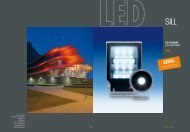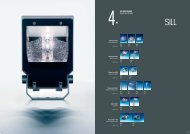5 years - Sill Lighting
5 years - Sill Lighting
5 years - Sill Lighting
You also want an ePaper? Increase the reach of your titles
YUMPU automatically turns print PDFs into web optimized ePapers that Google loves.
Luminaire luminous flux LlmThe luminaire luminous flux (Llm)defines the usable light of theluminaire and is the decisivevalue for the light planning. Asopposed to the lamp luminousflux (lm), the luminaire luminousflux (Llm) is subject to losses dueto the design of the luminaire.WILA defines only the Llm valuefor all LED lamps. This value canbe found both in data sheets andin the relevant ldt file.System efficiency Llm/WThe system efficiency defines theratio of luminaire light flux (Llm) tothe power input (W). Efficiencylosses due to operating deviceshave already been taken intoaccount by WILA in the Llm/Wvalue.Beam Spread Angle γThe beam spread angle γ isdefined as the angle at which theluminous intensity drops to 1%of the maximum value lmax. It ismeasured from the vertical (seeluminous intensity distributioncurve) and is an importantdimension in glare reducingmeasures. The beam spreadangle usually corresponds to theangle from which the luminanceis limited to values below 1000cd/m 2 (see the shaded area onthe luminous intensity distributioncurve). In the case of luminaireswith an asymmetrical beam, "as"is given in the table rather thanthe beam spread angle.divergence angle is given as afull angle, see beam chart in thechapter planning examples.Beam spread characteristicsuper spot < 10°spot 10° - 20°flood 21° - 45°wide flood 46° - 55°very wide flood > 55°UGRThe UGR method takes intoaccount the layout of theluminaires in the room andevaluates the glare produced bythe entire lighting system for aspecific observer's position. Alow UGR value means that theglare is negligible or non-existent.The provided UGR values takethe observer’s position parallelto the longitudinal axis of theLuminaire and the Lamp-/Luminaire axis parallel to thelonger side of the room intoaccount (s. graphic).UGR method is implementedon the basis of simple tablesprovided by the luminairemanufacturers.Suitability examples UGR value:< 16 for drafting rooms,< 19 for offices and controlrooms,< 22 for precision industrial tasksand< 28 for heavy industrial tasks.Number of Luminaires No. Lum.The number of luminaires(No. Lum.) is an approximateplanning factor that can be usedto calculate simply and quicklythe actual number of luminairesnecessary to provide a room withan illuminance of 100 lx. Thevalues are based on a surfaceof 100 m 2 (room ratio 2:3) anda room height of 3 m. Thereflectances used are 80/50/20%(ceiling, walls, floor) and thecalculation is based on amaintenance factor of 0.8.The approximate number ofluminaires can be calculatedusing the following formula:nominal number of luminaires= room area in m 2 x Em in lx xnumber of luminaire / (100 lx x 1m 2 ).Calculation example number ofluminaire: The aim is to determinethe number of lights necessary toattain an illuminance of 500 lx ina 50 m² room. The table for thechosen light states number ofluminaire = 0.07.This produces the following:50 m² x 500 lx x 0.07 lights /(100 lx x 1 m²) = 17.5 ≈ 18 lights.ProtectionIP44IIIVDE: approved byVDE, GermanyGames area proofType of protectionProtection class IIIF markingAll WILA luminaires are suitablefor use in or on ceilings of normalflammability and have been so farbeen labelled with the F marking.With the publication of theEN 60598 standard, date ofissue 09/2009, this marking is nolonger applicable. After the endof the transitional phase on12.04.2012, all lamps withoutmarking are suitable for use in oron a ceiling of normal flammability.Lamps, which do not fulfil thethermal requirements, will bemarked with a new pictogramin the future.Direct beamE0837-04 + 86210R2390°60°45°30° 15° 15° 30°300 cd/klm90°60°45°Direct/indirect beamAV2206-53Indirect beamC8006-44150°900 cd/klm120°150°120°Half-peak Divergence angle αFor accent lighting, the half-peakdivergence angle α is given ratherthan the beam spread angle.The half-peak divergence anglea is defined as the angle of therotationally symmetrical luminousintensity distribution at which theluminous intensity equals half ofits maximum value. In the productspecifications, the half-peak60°30° 30°300 cd/klm60°Luminous intensity distributionIn order to give a cleareroverview, the luminous intensitydistribution curves have beendivided into groups. The diagramshows the planes from 0° to180° (red line) and from 90° to270° (blue line). The 0° plane ison the right.www.wila.com 157






